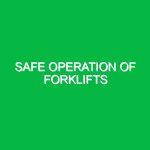Introduction
Excavation and trenching safety is a critical aspect of the Health, Safety, and Environment (HSE) domain. It encompasses the practices and regulations designed to protect workers involved in excavation and trenching activities. These activities, while essential for construction, utility work, and other projects, come with inherent risks that can lead to serious injuries or fatalities if not managed properly. Understanding these risks and implementing effective safety measures is paramount for ensuring worker safety and compliance with legal standards.
In the United States alone, the Occupational Safety and Health Administration (OSHA) estimates that trenching and excavation operations are among the most dangerous jobs in the construction industry. The statistics are sobering: every year, dozens of workers are killed, and hundreds are injured in trench-related incidents. With this context, it’s imperative to delve into the specifics of excavation and trenching safety, identifying potential hazards, safety precautions, and the regulations that govern these activities.
Identifying Hazards and Risks in Excavation and Trenching
Excavation and trenching work can present numerous hazards. Here’s a detailed look at some of the most common risks associated with these activities:
1. Cave-ins
Cave-ins are the most significant risk in trenching operations. When the walls of a trench collapse, workers inside can be buried under tons of soil, leading to severe injury or death. According to OSHA, cave-ins are responsible for about 75% of excavation fatalities. Factors that contribute to cave-ins include:
- Soil type: Sandy or loose soil is more prone to collapse.
- Water accumulation: Rain or nearby water sources can weaken soil structure.
- Vibration: Heavy machinery operating nearby can destabilize trench walls.
2. Falls
Workers can easily fall into unprotected trenches. A fall can occur when workers are moving around the site, especially in low visibility or when there are no protective barriers in place. It’s essential to have adequate fall protection measures, especially in deep trenches.
3. Hazardous Atmospheres
Excavation sites can sometimes contain harmful gases or vapors, especially in urban areas or near chemical plants. Workers must be aware of the potential for oxygen-deficient or toxic atmospheres. Regular air quality monitoring is essential to ensure safety.
4. Equipment Hazards
Heavy machinery such as backhoes and excavators are common in excavation work. The risk of equipment-related accidents is significant. Operators must be properly trained and aware of their surroundings to prevent injuries to themselves and others.
5. Utility Strikes
Underground utilities, such as gas, water, and electric lines, can pose serious hazards. Striking a utility line can lead to explosions, electrocution, or flooding. It’s crucial to conduct thorough site assessments and use appropriate detection equipment before digging.
Safety Precautions and Best Practices
To mitigate the risks outlined above, implementing robust safety precautions is vital. Here are some actionable recommendations:
1. Proper Training and Competence
All workers involved in excavation and trenching must receive comprehensive training. This training should cover hazard recognition, proper use of protective equipment, and emergency response procedures. Regular refresher courses can help maintain awareness of safety protocols.
2. Use of Protective Systems
OSHA mandates the use of protective systems for trenches deeper than five feet. These systems may include:
- Shoring: Using supports to prevent soil movement.
- Shielding: Installing trench boxes to protect workers.
- Sloping: Cutting back trench walls at an angle to reduce the risk of cave-ins.
3. Regular Inspections
Before starting work each day, a competent person should inspect the excavation site for potential hazards. This includes checking for signs of soil movement, water accumulation, and ensuring that protective systems are in place and functioning correctly.
4. Use of Personal Protective Equipment (PPE)
Workers should wear appropriate PPE, including hard hats, steel-toe boots, high-visibility clothing, and respiratory protection if needed. Ensuring that all PPE is in good condition and used correctly can significantly reduce the risk of injury.
5. Implementing a Safety Plan
Developing a comprehensive excavation safety plan is essential. This plan should outline the procedures for safe excavation, emergency response protocols, and roles and responsibilities of all personnel involved. Regularly reviewing and updating the plan based on new risks or incidents is crucial for ongoing safety improvement.
Understanding Regulations and Standards
Various regulations govern excavation and trenching safety, particularly in the United States. OSHA standards, specifically 29 CFR Part 1926 Subpart P, outline the requirements for trenching and excavation operations. Key aspects of these regulations include:
1. Competent Person
OSHA defines a “competent person” as someone who is capable of identifying existing and predictable hazards in the surroundings or working conditions. This person must be present at every excavation site, making decisions regarding safety measures and practices.
2. Soil Classification
Understanding the type of soil at the excavation site is a requirement under OSHA regulations. Soil is classified into categories such as cohesive, granular, and other specific types, which dictate the necessary protective measures to prevent cave-ins.
3. Protective Systems
As mentioned earlier, OSHA specifies the use of protective systems based on the depth and type of excavation. Compliance with these regulations is not just a legal obligation but a critical step in ensuring worker safety.
Real-Life Examples and Insights
When discussing safety in excavation and trenching, real-life incidents can provide powerful lessons. For instance, a construction company in Texas faced significant penalties after a trench collapse resulted in the death of a worker. Investigations revealed that the site had not been properly inspected, and adequate protective measures were not in place. Following this tragedy, the company implemented stricter safety protocols and retraining for all employees. They learned the hard way that no project is worth a life, and safety must be prioritized above all.
Conversely, a small plumbing firm in California embraced excavation safety practices and experienced no incidents over a five-year period. Their secret? Continuous training, regular site inspections, and a culture of safety that encouraged workers to speak up about hazards. This proactive approach not only protected their employees but also enhanced their reputation and efficiency.
Conclusion
Excavation and trenching safety is a multifaceted issue that requires diligence, training, and adherence to regulations. The risks involved are significant, but with the right precautions and a strong safety culture, these hazards can be effectively managed. Workers deserve to return home safely after every shift, and it is the responsibility of employers to ensure that safety is woven into the very fabric of every excavation project. By staying informed, prepared, and proactive, we can safeguard not only our workers but also the integrity of the projects we undertake.


